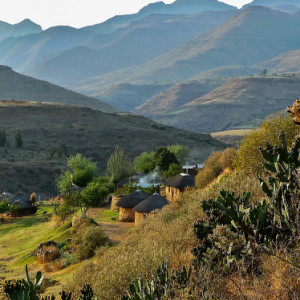Celestial Light
I have been struggling with a cold that became a sinus infection, and I am finally coming back to health with the help of antibiotics and rest. While most of my story about the years in southern Africa is about people and relationships, I want to pay attention also to the land, to what the land has to offer, and to the light…. Oh, and P.S. my camera came back to me today from the land of repairs. I was bereft without it.
The Extra is a photo of the land, taken on my final visit to Lesotho in 2010.
—————————
Throughout October and November, right up to the break for Christmas holidays, I held hiccuping, start-and-stop, unpredictable AIDS theatre rehearsals. Never the same group of actors twice. Never a full cast. Never a complete run-through. I got to know each actor and marveled as each developed their characters and found movements I would never have imagined—spinning, stomping, gesticulating, or dancing, then suddenly, dramatically still and stiffened with dignity. They all had “stage sense,” an awareness of their own embodiment of a character performing for an audience; a sense of comedy; joy. Their bodies and voices were so expressive that I didn’t worry about understanding their words.
I gave up expecting anyone to arrive on time, to work as an ensemble, to take direction. I gave up trying to “facilitate.” I held space for actors to be seen and appreciated—by me and by whatever gaggle of onlookers might peer at us, whether we were rehearsing in an abandoned building, in an empty classroom, or in an open field. When as many as ten of the fifteen-member cast materialized, actors congratulated each other with ululations and applause. When only one or two people came, we would practice monologues or two-person scenes. If no one arrived, I would wait for at least two hours, gazing into the light and writing in my journal.
Always, wherever we met, there was beyond and around us an intense and penetrating light I’ve seen only in Lesotho: golden light, clear light, celestial light. Is it the altitude? The lack of pollution? Through the light, I saw buttery sandstone cliff-sides dotted with thatched round houses; angular cement-block houses under sheets of corrugated metal; colorful blankets and clothing flapping on washing lines and over bushes and fences; and trash: plastic bags, dead batteries, bits of styrofoam, plastic bottles. But what I remember best is the vegetation.
There are willow trees, fruit trees, roses, and Italian poplars imported by French and Italian Roman Catholic missionaries in the 19th century. British administrators made the country a Protectorate they called Basutoland and sent in administrators who added to the mix of exotic plants and imported eucalyptus from Australia. Now stream-hugging willow trees burst into chartreuse leaf in September, and by October peach and apricot trees fill with hard green knobs that can become fruit if hungry children wait till they ripen. (Most will be eaten green.) Basotho have learned to use eucalyptus to nurse colds and clear lungs. Indigenous plants include aloes and plants I recognize by names used in the southwestern USA: yucca, maguey, century plants, prickly pear, red hot pokers. A botanist arrived on a field trip and told me there are tiny wildflowers in the mountains that grow nowhere else on earth.
Dazzled by my privilege every waking moment, as the days grew longer and we moved into summer, I knew Christmas was coming. My son Seth was coming. He was nineteen, eager to prove himself an adult. Leaving him and worrying about him, being unable to be in touch (in a time before cell phones, before email, before Facebook) had been the hardest thing about this adventure. I couldn’t wait to see him and to show him this world I had come to love, to see him in the land and to see the affect of the land on him.


Comments
Sign in or get an account to comment.


